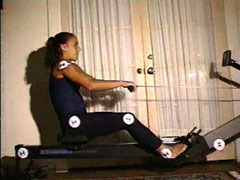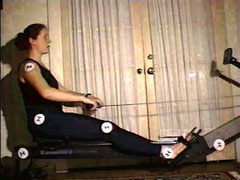METHODS
In our experiment, we used two subjects, each of which performed the same activity; rowing on the Concept II rowing machine. Subject 1 is a 20 year old female, who is 1.57 m, and 534 N (54.5 kg). She is also an experienced gymnast who has never tried rowing. Because of her lack of experience, we describe her as being a "novice" rower. Subject 2 is a 20 year old female, who is 1.82 m, and 780 N (79.5 kg). She is also an experienced rower, who has trained on the Concept II rowing machine frequently for the past two years. Both subjects 1 and 2 wore long blue spandex pants, and a dark colored sleeveless spandex shirt. The purpose of this clothing was to make sure that the markers stood out against it, that the subject stood out against the background, and also that we are able to see the joints and body segments more easily. Neither subject 1 nor subject 2 wore shoes or socks of any kind. This was to make sure that the markers on the lateral malleolus (ankle), stood out, and also, to eliminate possible discrepancies between the two subjects due to their footwear. Both subjects have joint markers on the right acromion process (shoulder), the right greater trochanter, (hip), the right lateral epichondyle (knee), and the right lateral malleolus (ankle).
|
|
|
|
Figure 1. Joint markers in Subject 1/ novice rower (left) and Subject 2/ experienced rower (right). Joint markers were placed on the acromion process, the greater trochanter, the lateral epichondyle, and the lateral malleolus. | |
The type of camera used to videotape our subjects was a Panasonic Hi-8 videocamera. The video frame rate used was 30 frames/sec. The environment in which we collected our data was a well lit room, with a flat, white background. We chose this background so that our subjects would be seen easily in their dark clothing. Due to a large glare, we used only a flood light to illuminate the subject. This allowed us to get an even light distribution, and minimize glare. Because the rowing stroke takes place in the saggital plane, the camera was positioned to record our subjects along the frontal axis of rotation, otherwise known as the mediolateral axis of rotation. The subjects were instructed to perform 8-10 strokes at a stroke rate of 18. This means that each subject rowed at a rate of 18 strokes per min (spm). We chose 18 spm so that our data could be analyzed using the equipment available, which is not as accurate when analyzing a quick motion. Each subject performed three separate trials so that we could be sure to obtain an accurate depiction of each subject. Each trial consisted of 8-10 strokes at 18 spm. When we selected which movement to use for analysis, we found examples that were a good representation of how each subject performed. In other words, we tried not to use a sequence that involved a movement uncharacteristic of the subject throughout the trials. The actual motion analyzed was the portion of the rowing stroke between the catch and the release. The starting position, the catch, is the position in which the subject is fully compressed, and about to move powerfully backwards through the drive to the release. The release is the end of the stroke, which is described as the position in which the knees are straight, the legs are parallel to the ground, and the seat and handle have stopped moving. Therefore, all of our data and graphs show information that began with the subject at the catch, and ends with the subject at the release.
The videotaped images were digitized at 30 frames/s using FusionRecorder on Macintosh computers in the New Media Center at the University of Michigan. The digital video files were trimmed using MoviePlayer so that the data files contained only the frames between the catch and the release. A custom utility (QT->PICT) was used to convert the QuickTime movie files into a series of individual frame files in PICT format for use with the Motion Plus software. Shoulder, hip, knee, and ankle markers were digitized using Motion Capture. Joint marker coordinate data were exported in spreadsheet format to Excel for biomechanical analysis using MotionAnalyse."

